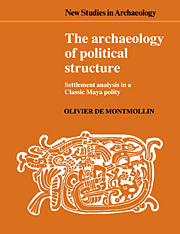Book contents
- Frontmatter
- Contents
- List of figures
- List of tables
- Preface
- 1 Studying ancient complex polities
- 2 Thinking about Maya political structure
- 3 The Rosario polity
- 4 Linking Maya politics and settlement
- 5 Centralization
- 6 Differentiation and integration
- 7 Political regimes and microcosms
- 8 Political stratification patterns
- 9 Mechanical versus organic solidarity
- 10 Segmenting versus non-segmenting organization
- 11 Archaeological study of Maya polities
- Notes
- References
- Index
9 - Mechanical versus organic solidarity
Published online by Cambridge University Press: 29 March 2010
- Frontmatter
- Contents
- List of figures
- List of tables
- Preface
- 1 Studying ancient complex polities
- 2 Thinking about Maya political structure
- 3 The Rosario polity
- 4 Linking Maya politics and settlement
- 5 Centralization
- 6 Differentiation and integration
- 7 Political regimes and microcosms
- 8 Political stratification patterns
- 9 Mechanical versus organic solidarity
- 10 Segmenting versus non-segmenting organization
- 11 Archaeological study of Maya polities
- Notes
- References
- Index
Summary
The mechanical-organic solidarity distinction finds distant inspiration in Durkheim's studies on the division of labor in society (Chapter 2; Durkheim 1933). Mechanical arrangements feature economically autarchic constituent units, limited exchange, and independence of parts. Contrarily, organic arrangements have a great deal of economic specialization among constituent units, extensive exchange, and interdependence of parts. It then follows (or does it?) that mechanical arrangements tend to be less solidary and less cohesive than organic ones, especially as scale increases. Aspects of the Rosario settlement record may be used to address the fourth set of research questions. What was the degree of mechanical versus organic economic solidarity that characterized Classic Maya society (4a)? If there was markedly mechanical economic solidarity, how closely was this associated with segmentary political structure (4b)?
My analysis of the mechanical–organic continuum in the Rosario polity must be quite a summary one, in keeping with a primary focus on politics (rather than economics), and to remain within the limitations imposed by very sketchy archaeological evidence concerning the presence or absence of economic specialization. However, at least some preliminary conclusions can be reached about the position of the Rosario polity and its districts along the mechanical to organic solidarity continuum. However imperfect, these conclusions are worthwhile in order to give at least some economic underpinning to the predominantly social and political factors investigated so far.
Certain patterns, which are potentially recoverable through archaeological survey methods, allow a distinction to be made between mechanical and organic solidarity. These patterns shed light on the question of relative community (site)-scale involvement in basic agricultural production activities.
- Type
- Chapter
- Information
- The Archaeology of Political StructureSettlement Analysis in a Classic Maya Polity, pp. 197 - 205Publisher: Cambridge University PressPrint publication year: 1989

